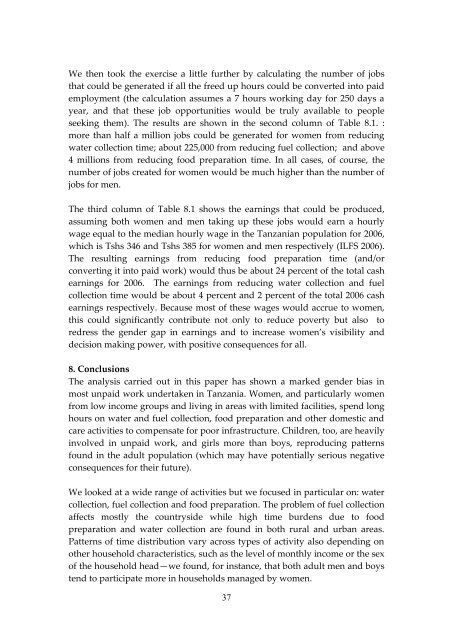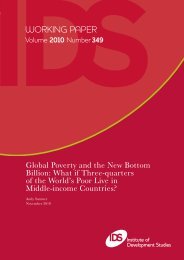Patterns of time use in Tanzania: how to make public investment in ...
Patterns of time use in Tanzania: how to make public investment in ...
Patterns of time use in Tanzania: how to make public investment in ...
Create successful ePaper yourself
Turn your PDF publications into a flip-book with our unique Google optimized e-Paper software.
We then <strong>to</strong>ok the exercise a little further by calculat<strong>in</strong>g the number <strong>of</strong> jobs<br />
that could be generated if all the freed up hours could be converted <strong>in</strong><strong>to</strong> paid<br />
employment (the calculation assumes a 7 hours work<strong>in</strong>g day for 250 days a<br />
year, and that these job opportunities would be truly available <strong>to</strong> people<br />
seek<strong>in</strong>g them). The results are s<strong>how</strong>n <strong>in</strong> the second column <strong>of</strong> Table 8.1. :<br />
more than half a million jobs could be generated for women from reduc<strong>in</strong>g<br />
water collection <strong>time</strong>; about 225,000 from reduc<strong>in</strong>g fuel collection; and above<br />
4 millions from reduc<strong>in</strong>g food preparation <strong>time</strong>. In all cases, <strong>of</strong> course, the<br />
number <strong>of</strong> jobs created for women would be much higher than the number <strong>of</strong><br />
jobs for men.<br />
The third column <strong>of</strong> Table 8.1 s<strong>how</strong>s the earn<strong>in</strong>gs that could be produced,<br />
assum<strong>in</strong>g both women and men tak<strong>in</strong>g up these jobs would earn a hourly<br />
wage equal <strong>to</strong> the median hourly wage <strong>in</strong> the <strong>Tanzania</strong>n population for 2006,<br />
which is Tshs 346 and Tshs 385 for women and men respectively (ILFS 2006).<br />
The result<strong>in</strong>g earn<strong>in</strong>gs from reduc<strong>in</strong>g food preparation <strong>time</strong> (and/or<br />
convert<strong>in</strong>g it <strong>in</strong><strong>to</strong> paid work) would thus be about 24 percent <strong>of</strong> the <strong>to</strong>tal cash<br />
earn<strong>in</strong>gs for 2006. The earn<strong>in</strong>gs from reduc<strong>in</strong>g water collection and fuel<br />
collection <strong>time</strong> would be about 4 percent and 2 percent <strong>of</strong> the <strong>to</strong>tal 2006 cash<br />
earn<strong>in</strong>gs respectively. Beca<strong>use</strong> most <strong>of</strong> these wages would accrue <strong>to</strong> women,<br />
this could significantly contribute not only <strong>to</strong> reduce poverty but also <strong>to</strong><br />
redress the gender gap <strong>in</strong> earn<strong>in</strong>gs and <strong>to</strong> <strong>in</strong>crease women’s visibility and<br />
decision mak<strong>in</strong>g power, with positive consequences for all.<br />
8. Conclusions<br />
The analysis carried out <strong>in</strong> this paper has s<strong>how</strong>n a marked gender bias <strong>in</strong><br />
most unpaid work undertaken <strong>in</strong> <strong>Tanzania</strong>. Women, and particularly women<br />
from low <strong>in</strong>come groups and liv<strong>in</strong>g <strong>in</strong> areas with limited facilities, spend long<br />
hours on water and fuel collection, food preparation and other domestic and<br />
care activities <strong>to</strong> compensate for poor <strong>in</strong>frastructure. Children, <strong>to</strong>o, are heavily<br />
<strong>in</strong>volved <strong>in</strong> unpaid work, and girls more than boys, reproduc<strong>in</strong>g patterns<br />
found <strong>in</strong> the adult population (which may have potentially serious negative<br />
consequences for their future).<br />
We looked at a wide range <strong>of</strong> activities but we foc<strong>use</strong>d <strong>in</strong> particular on: water<br />
collection, fuel collection and food preparation. The problem <strong>of</strong> fuel collection<br />
affects mostly the countryside while high <strong>time</strong> burdens due <strong>to</strong> food<br />
preparation and water collection are found <strong>in</strong> both rural and urban areas.<br />
<strong>Patterns</strong> <strong>of</strong> <strong>time</strong> distribution vary across types <strong>of</strong> activity also depend<strong>in</strong>g on<br />
other ho<strong>use</strong>hold characteristics, such as the level <strong>of</strong> monthly <strong>in</strong>come or the sex<br />
<strong>of</strong> the ho<strong>use</strong>hold head—we found, for <strong>in</strong>stance, that both adult men and boys<br />
tend <strong>to</strong> participate more <strong>in</strong> ho<strong>use</strong>holds managed by women.<br />
37

















